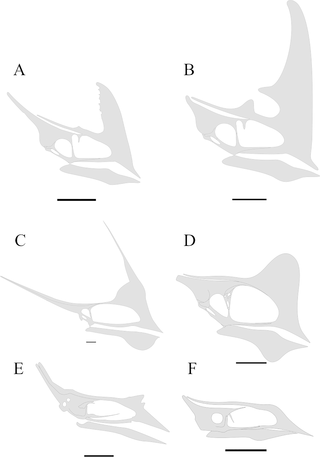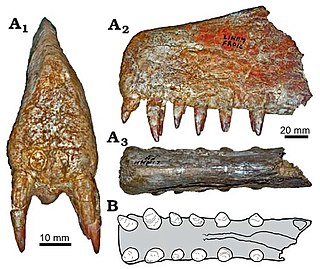
Cearadactylus is a genus of large anhanguerid pterodactyloid pterosaur from the Romualdo Formation of Brazil, South America. Fossil remains of Cearadactylus dated back to the Albian stage of the Early Cretaceous period, about 112 million years ago. The only known species is C. atrox, described and named in 1985 by Giuseppe Leonardi and Guido Borgomanero. The name refers to the Brazilian state Ceará, and combines this with Greek daktylos, "finger", a reference to the wing finger of pterosaurs. The Latin atrox means "frightful", a reference to the fearsome dentition of the species.

Tupuxuara is a genus of large, crested, and toothless pterodactyloid pterosaur from the Early Cretaceous period of what is now the Romualdo Formation of the Santana Group, Brazil, about 125 to 112 million years ago. Tupuxuara is a close relative of Thalassodromeus, and both form a group that is either called Thalassodrominae or Thalassodromidae.

Thalassodromeus is a genus of pterosaur that lived in what is now Brazil during the Early Cretaceous period, about a hundred million years ago. The original skull, discovered in 1983 in the Araripe Basin of northeastern Brazil, was collected in several pieces. In 2002, the skull was made the holotype specimen of Thalassodromeus sethi by palaeontologists Alexander Kellner and Diogenes de Almeida Campos. The generic name means "sea runner", and the specific name refers to the Egyptian god Seth due to its crest being supposedly reminiscent of Seth's crown. Other scholars have pointed out that the crest was instead similar to the crown of Amon. A jaw tip was assigned to T. sethi in 2005, became the basis of the new genus Banguela in 2014, and assigned back to Thalassodromeus as the species T. oberlii in 2018. Another species was described in 2015 based on a supposed crest fragment, but this was later shown to be part of a turtle shell.

Arambourgiania is an extinct genus of azhdarchid pterosaur from the Late Cretaceous period of Jordan, and possibly the United States. Arambourgiania was among the largest members of its family, the Azhdarchidae, and it is also one of the largest flying animals ever known. The incomplete left ulna of the "Sidi Chennane azhdarchid" from Morocco may have also belonged to Arambourgiania.

Tapejaridae are a family of pterodactyloid pterosaurs from the Cretaceous period. Members are currently known from Brazil, England, Hungary, Morocco, Spain, the United States, and China. The most primitive genera were found in China, indicating that the family has an Asian origin.
Brasileodactylus a genus of pterosaur from the Aptian-age lower Santana formation of Chapada do Araripe, Ceará, Brazil.

Siroccopteryx is an extinct genus of anhanguerid pterodactyloid pterosaur, known from middle Cretaceous sediments in modern-day Morocco. Some researchers, such as David M. Unwin, consider the genus a junior synonym of Coloborhynchus.

Ludodactylus is a genus of anhanguerid pterodactyloid pterosaur from the Early Cretaceous period of what is now the Crato Formation of the Araripe Basin in Ceará, Brazil. The type and only species is L. sibbicki. The generic name Ludodactylus refers to the fact that the animal had the combination of teeth and a Pteranodon-like head crest, similar to many toy pterosaurs, and no such creature was known to exist until the discovery of Ludodactylus. However, Ludodactylus is not the only pterosaur known to possess these features, its very close relative Caulkicephalus is another example.

Liaoningopterus, sometimes misspelled as "Liaoningopteryx", was a genus of anhanguerid pterodactyloid pterosaur from the Barremian-Aptian-age Lower Cretaceous Jiufotang Formation of Chaoyang, Liaoning, China.

Tupandactylus is a genus of tapejarid pterodactyloid pterosaur from the Early Cretaceous Crato Formation of Brazil.
Elanodactylus is a genus of ctenochasmatid pterodactyloid pterosaur from the Early Cretaceous period of what is now the Yixian Formation of Liaoning, China.

Ornithocheiridae is a group of pterosaurs within the suborder Pterodactyloidea. These pterosaurs were among the last to possess teeth. Members that belong to this group lived from the Early to Late Cretaceous periods, around 140 to 90 million years ago.

Lacusovagus is a genus of azhdarchoid pterodactyloid pterosaur from the Lower Cretaceous of Brazil. It is based on SMNK PAL 4325, a partial upper jaw comprising sections of the skull in front of the eyes. This specimen was found in rocks of the Early Cretaceous-age Nova Olinda Member of the Crato Formation. The skull was long, and unusually wide. The section in front of the combined nasal-antorbital fenestra was relatively short. Also unusual was the combination of its toothless jaws and no bony head crest. Lacusovagus was described in 2008 by Mark Witton. The type species is L. magnificens, meaning "grand lake wanderer", in reference to its large size—it is currently the largest pterosaur known from the Crato Formation with an estimated wingspan of approximately 4 metres (13 ft) and a body mass of 30 kg (66 lb).

Pterosaurs included the largest flying animals ever to have lived. They are a clade of prehistoric archosaurian reptiles closely related to dinosaurs. Species among pterosaurs occupied several types of environments, which ranged from aquatic to forested. Below are the lists that comprise the smallest and the largest pterosaurs known as of 2022.

Thalassodrominae or Thalassodromidae is a group of azhdarchoid pterosaurs from the Cretaceous period. Its traditional members come from Brazil, however, other possible members also come from other places, including the United States, Morocco, and Argentina. Thalassodrominae is considered either to be a subfamily within the pterosaur family Tapejaridae, or as a distinct family, Thalassodromidae, within the clade Neoazhdarchia, closely related to dsungaripterids or azhdarchids.

This timeline of pterosaur research is a chronologically ordered list of important fossil discoveries, controversies of interpretation, and taxonomic revisions of pterosaurs, the famed flying reptiles of the Mesozoic era. Although pterosaurs went extinct millions of years before humans evolved, humans have coexisted with pterosaur fossils for millennia. Before the development of paleontology as a formal science, these remains would have been interpreted through a mythological lens. Myths about thunderbirds told by the Native Americans of the modern Western United States may have been influenced by observations of Pteranodon fossils. These thunderbirds were said to have warred with water monsters, which agrees well with the co-occurrence of Pteranodon and the ancient marine reptiles of the seaway over which it flew.

Ornithocheiromorpha is a group of pterosaurs within the suborder Pterodactyloidea. Fossil remains of this group date back from the Early to Late Cretaceous periods, around 140 to 92.5 million years ago. Ornithocheiromorphs were discovered worldwide except Antarctica, though most genera were recovered in Europe, Asia and South America. They were the most diverse and successful pterosaurs during the Early Cretaceous, but throughout the Late Cretaceous they were replaced by better adapted and more advanced pterosaur species such the pteranodontids and azhdarchoids. The Ornithocheiromorpha was defined in 2014 by Andres and colleagues, and they made Ornithocheiromorpha the most inclusive clade containing Ornithocheirus, but not Pteranodon.

Aymberedactylus is a genus of tapejarid pterosaur from the Early Cretaceous Crato Formation of Brazil. It contains a single species, A. cearensis.



























